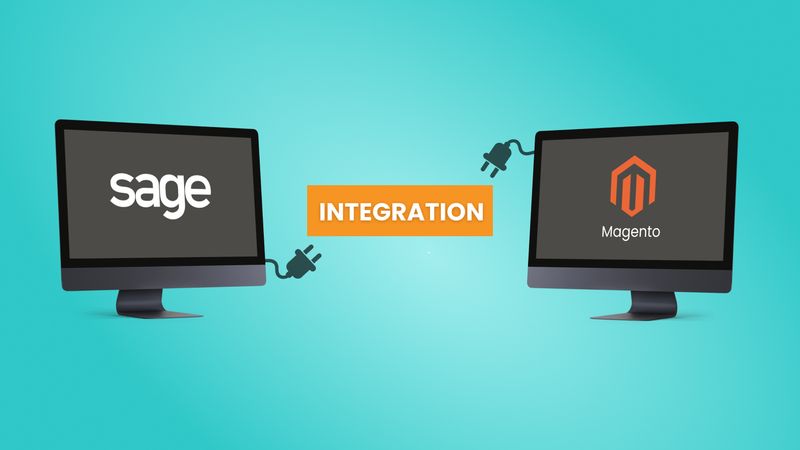
Why are so many ten-, twenty-, and even 30-year-old CPG companies scrambling to integrate their SAGE ERP with Magento? Because modern business workflows have become incredibly complicated. Administrators and customers are demanding new levels of data integrity and information accuracy. Manual and error-prone methods of managing data, inventory, finances, and people cannot compete with synchronized systems. And customers want a frictionless journey, fast shipping, and real-time order status updates. Today, software integration is what keeps companies competitive and makes multi-channel or omnichannel business possible. By integrating your tried-and-true SAGE ERP with Magento, you can unify the data and information shared between them.
SAGE — The Brain of Your Business
The SAGE ERP has been around in one version or another since 1994. Its latest iterations include SAGE 100, SAGE 300, and SAGE X3.
SAGE is a long-term data management solution. It governs processes related to master product data, inventory, orders, invoices and accounting, reporting, production, supply chain, delivery, data asset management, human resources, and more.
Powerful as this ERP is, it cannot deliver the complex storefront features that keep your business moving forward and your customers happy. That’s where Magento comes in.
MAGENTO — Your eCommerce Hub
More than 250,000 businesses around the world run their websites on Magento. It’s easy to see why. Magento is one of the most powerful and flexible eCommerce platforms around.
Magento It has modern tools for content creation, personalization, and promotion. It enables B2B and B2C merchants to sell and fulfill from anywhere. And Magento’s sophisticated business intelligence dashboards offer deep data insights to guide future growth.
But perhaps our favorite aspect of Magento is that it works well with other software—especially ERPs.
What Are The Benefits of SAGE and MAGENTO Integration?
Whether Magento “pushes” data to SAGE or SAGE “pulls” data from Magento (more on this below), ERP integration will make your business operations more accurate across all systems. This kind of communication provides benefits on the backend and the front end.
Integration Streamlines Operations and Boosts Productivity
- Eliminates manual data entry with either real-time (API-driven) data exchange or periodic automated flat-file transfers.
- Reduces costly data errors caused by manual data entry (ex. SKU or address typos)
- Frees employees to focus on more important tasks such as shipping
- Ensures data integrity across your entire organization
- Cuts order processing time from minutes to seconds in some cases
Integration Improves the Front-End Customer Experience
- More accurate order processing = fewer customers complaints after checkout
- Offer and meet shorter online order delivery times
- Support multiple fulfillment options (buy online pick up in-store, etc.)
- Run flash sales and other time-sensitive promotions
- Display accurate inventory levels, product listings, and prices
If the way to a more streamlined business (and happier customers) is integration, how can you get there?
How SAGE and MAGENTO Integration Works
Integrating SAGE and Magento is a complex process. And though every business is unique, all ERP integration projects share three common elements:
- File Exchange: Defining how data travels back and forth
- Data Mapping: Defining the touchpoints where SAGE and Magento connect
- End-to-End Testing: Ensuring seamless operation across all systems
Let’s break down each element to help you understand the process of integration.
FILE EXCHANGE
File exchange is how SAGE and Magento communicate. One of the reasons we love Magento is that it supports all methods of data transfer: flat-file exchange, SOAP, REST, and GraphQL.
Among SAGE and Magento integrations, the flat-file exchange is the most common. It is also a simple and flexible approach that will serve most B2C and B2B businesses well. File exchange periodically (hourly or daily) pushes or pulls data in CSV or XML formats from one system to the other via shared folders.
Some data, like order information, must flow both ways so administrators and customers can see the status of orders in real-time. Other data, such as master product data, is managed entirely in SAGE and then shared with Magento for display.
Your integration partner will also structure the exchange to reduce file exchange bottlenecks. For example, if you have 20,000 SKUs but stock quantities only changed on 50 of them today, only those SKUs where data fields changed will be exported in what is called DIFF file. This brings us to the next element of ERP integration.
DATA MAPPING
Data Mapping is the most time-intensive part of ERP integration.
Most businesses are familiar with the concept of data creep, where data fields related to products and customers change and expand steadily year over year. Some data fields may not all share the same language, some may use text instead of numbers, and some may house multiple data types (example: height, width, and depth measurements).
We’ll work with you to normalize the data fields in your SAGE ERP. Then we’ll (assign) those touchpoints from the source system to the target system in its database. Data updates are shared between the systems based on the file exchange process discussed above. Accurate data mapping and regular file exchange are the foundation of synchronized systems.
It is worth noting that some product attributes such as descriptions or assets like the image(s), can be managed directly in Magento, which can save more time.
END-TO-END TESTING
The final phase of SAGE and Magento integration involves extensive testing. At DotcomWeavers, we test everything, from the customer journey to the way your administrators interact with SAGE and Magento.
E2E testing is the proving ground for business logic. For example, if offer split shipments or tiered pricing, this phase ensures that those function properly. Testing is the crucial time to find bugs, data errors, image issues, product pricing differences, etc., so you can launch with confidence.
How to Prepare for SAGE and MAGENTO Integration
Integrating Sage and Magento is a complex process. Proper preparation will help ensure that the project stays on track. Set aside resources to cover these preliminary steps before starting your integration.
Check Your Systems
In general, best practices in eCommerce call for regular system upgrades. As discussed above, Magento 2 is extremely flexible and the latest versions of SAGE 100, 300, and X3 should support integration. If you aren’t on the latest versions, your integration partner may suggest upgrading them first. This is a special concern for businesses still running on versions of Magento 1.0, which face issues related to Magento 1 End of Life.
Review Your Data
Data must be scrubbed and normalized before integration. Some integration partners offer this service, others may suggest 3rd-party support. Remember to assess the state of your data before embarking on a SAGE integration project.
Analyze Your Processes
What are the critical touchpoints for each department? Do you need to connect everything all at once, or can you manage with only the key data fields mapped between Magento and SAGE? Assess all business processes to determine how integration will impact them.
Plan Your Budget
SAGE and Magento integrations are big and complex projects whose prices can vary greatly depending on their extent. Talk to several potential partners to understand exactly what the lift will be. Remember that there may be additional costs for IT enhancements and post-launch updates.
Enlist Total Support
ERP integrations require buy-in from all key personnel in your business. Make sure the heads of every department are onboard before undertaking an integration.
SELECT-A-VISION: An Integration Case Study
Our long-time client, Select-A-Vision, is a textbook example of a seamless SAGE and Magento integration.
SAV built its business around brick-and-mortar sales using the SAGE ERP. They offered high-quality reading, sun, and computer glasses at affordable prices and had a loyal customer base. But as their customers began to buy more glasses online, SAV knew they needed to transform or get left behind.
They asked us to deliver a modern eCommerce solution with, you guessed it, a Magento—SAGE integration at its core. DotcomWeavers delivered.
DON’T WAIT TO GET STARTED!
One of the most common comments we get from new clients is: “we shouldn’t have waited so long to integrate our systems.”
eCommerce and business technology is developing at a relentless pace. Customer demands and expectations are changing all the time. You don’t need to scrap SAGE as your single-source-of-truth to keep up. But you do need to synchronize it with your eCommerce platform (Magento is our go-to) to help you stay competitive.
SAGE and Magento integration is a big undertaking. DotcomWeavers can help you navigate the process. Why not get the ball rolling by scheduling some time to speak with an ERP integration expert today?
The consultation is free and the information could help you transform your business!
Receive a Personalized Consultation for Your eCommerce Requirements!
Receive a Personalized Consultation for Your eCommerce Requirements!
